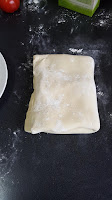
Weeks! It's been weeks since I've been meaning to try making donuts again. The first time I made them, a few months ago, they were too heavy. I figured that making the dough with the breadmaker would help. AND IT DID!!! Plus I found a better recipe.
It is so simple, probably can be done a lot quicker than what I did. But I just wanted to make the dough the previous night, and then cook them in the morning. I combined a few different methods that I read about.
Some notes on the ingredients. You may be wondering why I used psyllium husk, ginger and citric acid. Or you may not, but I'm going to tell you anyway.
I few weeks ago, when I started baking breads, I read about bread improvers. I used a commercially available one which I thought was vegan, but then the manufacturer confirmed that one of the ingredients was not. So that ingredient was abandoned.
A lot of people who are not in Australia were also asking where to get a bread improver, so I did a little bit of research and found a home made one which I have been using a variation of, in all my bread making.
This is the article about it. It uses lecithin granules, ginger, citric acid and wheat gluten. However I did not have lecithin granules, and I had read in another article that psyllium husk was a good bread conditioner. So I used that.
*Psyllium husk is quite coarse, so I blended a cup in a nut grinder (but you can use a blender) and have stored it in an air tight jar. I use it whenever I make breads now. I have also started using it for cakes, all recipes in experimental stage.
For those of you with little kids, psyllium husk makes a really great easy to do slime. My five year old loves it, and it's a lot better than the nasty chemical filled ones you can buy from the shops.
**************************************************************
Update - 16/10/2016
**************************************************************
I originally had the thickness of the dough at 1/4 inch, however this morning I tried it at 1/2-3/4 inch and it is a lot better. I have edited the recipe to that thickness.
**************************************************************
Ingredients
8 TBS
aqua faba (from chickpeas)
1 cup of warm soy milk (I use Soy Milky)
1/2 tsp vanilla
1/3 cup of sugar
1/4 cup of sunflower oil
Sift together
4 cups of plain flour
4 TBS wheat gluten (vital gluten)
2 tsp psyllium husk powder*
1/8 tsp of ginger powder
1/8 tsp of citric acid
3 tsp yeast
Rice bran oil or other oil without strong flavour for frying.
Method
Breadmaker
- Place ingredients in the breadmaker in the order listed above, starting with the aqua faba, and finishing with the sifted dry ingredients, and the yeast on top.
- Start the dough setting, let the dough rise. The breadmaker I have mixes and kneads (30 minutes) and then rises (1 hour).
- Remove dough from breadmaker. (if you want to make them right away, then go to step 5)
- Punch down the dough, form into a ball and place in a large oiled bowl. Cover with plastic wrap and place in the fridge overnight.
- Lightly flour your bench/table and place dough down. Punch dough down and roll out to about 1/2-3/4 inch in thickness.
- Cut into desired shapes and place on a baking tray lined with non stick paper. Cover with plastic wrap and place in a warm spot to rise for an hour.
- Heat oil in a deep pot or frying pan. You need enough oil so that when the donuts are placed in, they are floating and not touching the bottom. Pinch a small piece of dough and place it in the oil, if it floats to the top, with bubbling oil around it, the oil is ready for frying.
- Place your donuts in the oil, and cook them on each side for a few minutes. If they start to brown too quickly then the oil is too hot.
- Remove from oil, drain on kitchen paper, and then dust with sugar or fill as desired.
Hand Method
- Place milk, sugar and aqua faba in a jug.
- Add yeast, and mix, set aside for 10 minutes to proof.
- Make a well in the center of your dry ingredients, and pour in yeast/milk mix, add vanilla and oil. Mix together to form a dough.
- Knead on a floured surface for 15 minutes until the dough becomes smooth and elastic. You can do this on a stand mixer, as the dough is quite firm.
- Place dough in an oiled bowl to rise in a warm spot for 40 minutes.
- Follow steps 4-9 above if you are not making them right away, otherwise steps 5-9.
These can be filled with caramel, raspberry jam or rolled in caster sugar with cinnamon. I only fried half of the dough this morning, the rest of the dough is in the fridge for tomorrow. I will ice those with aqua faba icing, and put some sprinkles. I will share pictures when done.
Let me know in the comments if you have any questions.
Enjoy!!!
 Ingredients
Ingredients






















